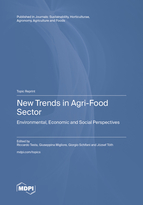Topic Menu
► Topic MenuTopic Editors




2. Faculty of Economics, Socio-Human Sciences and Engineering, Sapientia Hungarian University of Transylvania, Piaţa Libertăţii nr. 1, 530104 Miercurea Ciuc, Romania
New Trends in Agri-Food Sector: Environmental, Economic and Social Perspectives

A printed edition is available here.
Topic Information
Dear Colleagues,
It is our pleasure to extend this invitation to potentially interested researchers in the field of sustainable consumption and production. Over the last few years, the agri-food sector has had to face different challenges. The increase of the world population (destined to reach 9 billion by 2050) has led farmers and agri-food entrepreneurs to the over-exploitation of numerous agricultural systems in order to meet the growing food demand. However, in most cases, producers have only pursued an increase in their incomes, neglecting the environmental and social aspects of their productions. The search for ever greater yields and revenues has caused a worsening of agro-ecosystems (i.e. excessive use of chemical inputs and soil tillage, continuous cropping, deforestation), reducing their fertility and biodiversity, increasing environmental pollution and forcing people to leave rural areas, both farmers and agri-food firms. Moreover, if we consider that global warming requires us to rethink production processes in order to reduce GHG emissions, it appears necessary to adopt sustainable agri-food productions, from the economic, environmental and social points of view. In this context, the achievement of a sustainable agri-food sector depends not only on entrepreneurs’ choices, but also on consumer’s behaviour change and on incentives or subsidies towards an agroecology transition.
The Topic “New Trends in Agri-Food Sector: Environmental, Economic and Social Perspectives” tries to create a discussion on this topic. It includes but is not limited to the following relevant themes:
- Agroecology and organic farming;
- Green economy;
- Circular economy;
- Consumers’ behaviour;
- Innovation adoption;
- Sustainable development of rural areas.
Dr. Riccardo Testa
Dr. Giuseppina Migliore
Prof. Dr. Giorgio Schifani
Prof. Dr. József Tóth
Topic Editors
Keywords
- climate change
- consumer behavior
- environmental benefits
- profitability
- renewable energies
- sustainable consumption
Participating Journals
| Journal Name | Impact Factor | CiteScore | Launched Year | First Decision (median) | APC |
|---|---|---|---|---|---|

Sustainability
|
3.9 | 5.8 | 2009 | 18.8 Days | CHF 2400 |

Horticulturae
|
3.1 | 2.4 | 2015 | 14.7 Days | CHF 2200 |

Agronomy
|
3.7 | 5.2 | 2011 | 15.8 Days | CHF 2600 |

Agriculture
|
3.6 | 3.6 | 2011 | 17.7 Days | CHF 2600 |

Foods
|
5.2 | 5.8 | 2012 | 13.1 Days | CHF 2900 |

MDPI Topics is cooperating with Preprints.org and has built a direct connection between MDPI journals and Preprints.org. Authors are encouraged to enjoy the benefits by posting a preprint at Preprints.org prior to publication:
- Immediately share your ideas ahead of publication and establish your research priority;
- Protect your idea from being stolen with this time-stamped preprint article;
- Enhance the exposure and impact of your research;
- Receive feedback from your peers in advance;
- Have it indexed in Web of Science (Preprint Citation Index), Google Scholar, Crossref, SHARE, PrePubMed, Scilit and Europe PMC.

